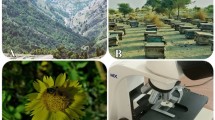Abstract
Visitation rates and assemblage composition of pollinators have often been related to environmental, ecological and phenotypic variables. However, the interaction between flowers and pollinators has not been evaluated in a biomechanical context. Floral rewards in keel flowers (Fabaceae, Faboideae) are concealed behind four joined petals, the keel-wing unit, and are accessible only if pollinators open this unit by exerting force on it. Force needed to open the flower is expected to affect the interaction with pollinators because pollinators must invest time and energy to open the keels. Consequently, plants with stiff flowers should be expected to experience diminished visitation frequency, particularly by weak visitors. To test this expectation of diminished visitation rates and of assemblage composition biased by pollinator strength, we measured the force needed to open the keel flowers of five co-occurring legume species and, using a canonical correspondence analysis (CCA), we tested their association with pollinator visitation rates and assemblage composition. We additionally included a size flag variable in CCA to test the effect of attractiveness on pollinator visits. There was no association between flower stiffness and visitation frequency. According to the CCA, pollinator assemblage compositions were associated with the force needed to open the keel and not flag size. As a general pattern, weak flowers are pollinated by an uneven assemblage of weak bees while the stiffest flowers are pollinated by an even assemblage of large and strong bees. These results supports the idea that force has an effect in controlling pollinator assemblage composition.

Similar content being viewed by others
References
Amaral-Neto LP, Westerkamp C, Melo GA (2015) From keel to inverted keel flowers: functional morphology of “upside down” papilionoid flowers and the behavior of their bee visitors. Plant Syst Evol 301(9):2161–2178
Aronne G, Giovanetti M, De Micco V (2012) Morphofunctional traits and pollination mechanisms of Coronilla emerus L. flowers (Fabaceae). Sci World J 2012.
Brantjes NBM (1981) Floral mechanics in Phlomis (Lamiaceae). Ann Bot-Lond 47:279–282
Claßen-Bockhoff R, Crone M, Baikova E (2004a) Stamen development in Salvia L.: Homology reinvestigated. Int J Plant Sci 165:475–498
Claßen-Bockhoff R, Speck T, Tweraser E, Wester P, Thimm S, Reith M (2004b) The staminal lever mechanism in Salvia L. (Lamiaceae): a key innovation for adaptive radiation? Org Divers Evol 4:189–205
Córdoba SA, Cocucci AA (2011) Flower power: its association with bee power and floral functional morphology in papilionate legumes. Ann Bot-Lond 108:919–931
Córdoba SA, Benitez-Vieyra S, Cocucci AA (2015) Functional modularity in a forcible flower mechanism: relationships among morphology, biomechanical features and fitness. Evol Ecol 29(5):719–732
Dauber J, Biesmeijer JC, Gabriel D (2010) Effects of patch size and density on flower visitation and seed set of wild plants: a pan-European approach. J Ecol 98:188–196
Eckhart VM (1991) The effects of floral display on pollinator visitation vary among populations of Phacelia linearis (Hydrophyllaceae). Evol Ecol 5:370–384
Faegri K, van der Pijl L (1966) The principles of pollination ecology. Pergamon Press, Canada
Gibson MR, Pauw A, Richardson DM (2013) Decreased insect visitation to a native species caused by an invasive tree in the Cape Floristic Region. Biol Conserv 157:196–203
Giovanetti M, Aronne G (2013) Honey bee handling behaviour on the papilionate flower of Robinia pseudoacacia L. Arthropod-Plant Interact 49(1): 25–32
Gower JC (1971) Generalized procrustes analysis. Psychometrika 40(1):33–51
Grindeland JM, Sletvold N, Ims RA (2005) Effects of floral display size and plant density on pollinator visitation rate in a natural population of Digitalis purpurea. Funct Ecol 19:383–390
Jackson DA (1995) PROTEST: a Procrustean randomization test of community environment concordance. Écoscience 2:297–303
Karron JD, Holmquist KG, Flanagan RJ, Mitchell RJ (2009) Pollinator visitation patterns strongly influence among-flower variation in selfing rate. Ann Bot-Lond 103:1379–1383
Kearns CA, Inouye WD (1993) Techniques for pollination biologist. University press of Colorado, Niwot
Oksanen J, Kindt R, Legendre P, O’Hara B, Simpson GL, Stevens MHH, Wagner H (2008) Vegan: community ecology package. R package version 1.13–2. (http://vegan.r-forge.r-project.org)
Parker IM, Engel A, Haubensak KA, Goodell K (2002) Pollination of Cytisus scoparius (Fabaceae) and Genista monspessulana (Fabaceae), two invasive shrubs in California. Madroño 49(1):25–32
Peres-Neto PR, Jackson DA (2001) How well do multivariate data sets match? The advantages of a Procrustean superimposition approach over the Mantel test. Oecologia 129:169–178
Rasband WS (2016) ImageJ, U. S. National Institutes of Health, Bethesda, http://imagej.nih.gov/ij/, 1997–2016
Reith M, Claßen-Bockhoff R, Speck T (2006) Biomechanics in Salvia flowers, the role of lever and flower tube in specialization on pollinators. In: Herrel A, Speck T, Rowe N (eds) Ecology and biomechanics: a mechanical approach to the ecology of animals and plants, CRC Press, Boca Ratón, pp 123–146
Reith M, Baumman G, Claßen-Bockhoff R, Speck T (2007) New insights into the functional morphology of the lever mechanism of Salvia pratensis (Lamiaceae). Ann Bot-London 100:393–400
Stöbbe J, Schramme J, Claßen-Bockhoff R (2016) Training experiments with Bombus terrestris and Apis mellifera on artificial ‘Salvia’ flowers. Flora 221:92–99
Stout JC (2000) Does size matter? Bumblebee behaviour and the pollination of Cytisus scoparius L. (Fabaceae). Apidologie 31:129–139
Ter Braak CJ (1986) Canonical correspondence analysis: a new eigenvector technique for multivariate direct gradient analysis. Ecology 67(5):1167–1179
Wester P, Claßen-Bockhoff R (2006) Hummingbird pollination in Salvia haenkei (Lamiaceae) lacking the typical lever mechanism. Plant Syst. Evol 257:133–146
Westerkamp C (1991) Honeybees are poor pollinators—why? Plant Syst Evol 177:71–75
Westerkamp C, Weber A (1999) Keel flowers of the Polygalaceae and Fabaceae: a functional comparison. Bot J Linn Soc 129(3):207–221
Acknowledgements
We thank CONICET for whom A.A.C is a researcher and S.A.C is a postdoctoral fellowship holder. We are also grateful to Dr Valeria Paiaro for useful input in a preliminary version of this manuscript. The study was supported by SECYT UNC (162/2012), CONICET (PIP 114-201001-00346) and MINCYT Córdoba (PID 2008–2011) grants.
Author information
Authors and Affiliations
Corresponding author
Additional information
Handling Editor: Isabel Alves dos Santos.
Rights and permissions
About this article
Cite this article
Córdoba, S.A., Cocucci, A.A. Does hardness make flower love less promiscuous? Effect of biomechanical floral traits on visitation rates and pollination assemblages. Arthropod-Plant Interactions 11, 299–305 (2017). https://doi.org/10.1007/s11829-017-9505-9
Received:
Accepted:
Published:
Issue Date:
DOI: https://doi.org/10.1007/s11829-017-9505-9




